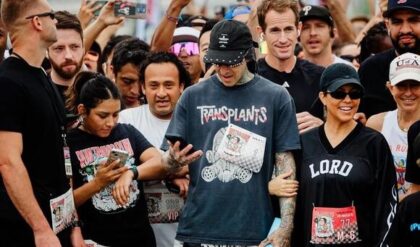New Netflix documentary reveals minute-by-minute how astronauts’ dreams of landing on the moon quickly gave way to a desperate fight for survival
WHEN Marilyn Lovell’s astronaut husband, Jim, blasted off aboard Apollo 13, the world watched with anticipation as he embarked on NASA’s third mission to the moon.
But disaster struck 200,000 miles from Earth, leaving Marilyn – and the world – watching with bated breath to see if the Apollo 13 crew would return from the doomed spacecraft.

12
The world watched with bated breath as the spaceship launched into spaceCredit: © 2024 Netflix, Inc.

12
Apollo 13 commander’s wife Marilyn Lovell and her children in Apollo 13: Survival on NetflixCredit: © 2024 Netflix, Inc.

12
Three of the crew members of Apollo 13 (left to right), Fred Haise, Jim Lovell, and Ken MattinglyCredit: Getty

12
Terrified Marilyn spent days listening to the radio and TV, not knowing if she was a wife or a widowCredit: © 2024 Netflix, Inc.
Now, a gripping Netflix documentary captures the heart-wrenching moment devoted Marilyn desperately waited for news on her beloved husband and father of her children.
The camera lingers on Marilyn’s radio – a symbol of both hope and dread – as she listens intently for updates on the crew stranded in space.
“I have never experienced anything like this in my life,” Marilyn, who sadly passed away last year, told reporters at the time. “For four days, I didn’t know if I was a wife or a widow.”
Her husband, Jim, and fellow astronauts Jack Swigert and Fred Haise were plunged into darkness when an oxygen tank exploded.
The crew heard a sudden bang and a warning light flashed as Swigert calmly radioed Mission Control with a now infamous line.
“Houston, we’ve had a problem,” he said in a voice that remained eerily calm, despite the unknown disaster unfolding aboard the doomed spacecraft.
Swigert’s comment at 9:08 pm on April 13, 1970, marked the moment America’s third moon mission spiralled into one of NASA’s biggest crises.
Just days earlier, the astronaut, along with commander Jim Lovell and fellow pilot Fred Haise, had set off with high hopes of reaching the lunar surface after Apollo 13 launched from US soil.
But their dreams of landing on the moon quickly gave way to a desperate fight for survival as their spacecraft faced catastrophic failure.
Just 56 hours into the venture, an oxygen tank exploded, damaging the craft and leaving them effectively stranded in space.
In a nail-biting string of events, the astronauts’ only option was to cram into a lunar lander to attempt the gruelling journey back to Earth, guided by mission controllers – as the world held its breath.
As one broadcaster spelled out at the time: “The Apollo 13 spacecraft is off course.
“If the astronauts cannot make the correction in their flight path the three Americans will die in space.”
Incredibly, on April 17, 1970 – six days after the doomed launch – the crew made it back to earth safely.

12
The crew of the Apollo 13 spacecraft, April 1970. Left to right: Command Module Pilot John Swigert, Commander Jim Lovell, and Lunar Module Pilot Fred HaiseCredit: Archive Photos – Getty

12
Inside the NASA space station as they awaited news of the doomed Apollo 13 missionCredit: © 2024 Netflix, Inc.
With never-before-seen footage, audio recordings, and fresh interviews, new Netflix documentary Apollo 13: Survival gives viewers a brand-new look at the terrifying ordeal that almost cost the crew their lives.
Apollo 13 was The National Aeronautics and Space Administration third moon-landing mission.
The launch from the Kennedy Space Centre in Florida came nine months after Neil Armstrong’s landing on the moon.
The space agency had hoped Apollo 13 would help them find out more about the “origin of the moon and, from that, the origin of the earth”.
We were so curious, so excited, that we were like kids looking into a candy store window
Astronaught John Swigert
Captain Lovell was 42 years old and the world’s most-travelled astronaut when he joined Apollo 13, with three missions and 572 spaceflight hours under his belt.
Lunar module pilot Haise, 36, had served as a fighter pilot for the US Marine Corps before joining NASA. Apollo 13 would be Haise’s only trip to space.
Swigert, the 38-year-old command module pilot, was asked to join the crew just 48 hours before the launch after Ken Mattingly was exposed to measles.
“We were so curious, so excited, that we were like kids looking into a candy store window,” one of the crew is heard saying.

12
Commander’s wife Marilyn Lovell and her kids anxiously waits for newsCredit: © 2024 Netflix, Inc.

12
Marilyn said it was “rough” being a wife of an astronaut. Pictured with her husband captain JimCredit: © 2024 Netflix, Inc.

12
A NASA picture shows astronaut Fred Haise, working inside the Apollo 13 lunar module after the explosion of the ship’s oxygen tanksCredit: AFP
Footage shows the men grinning inside their spacesuits as they prepare to board the Odyssey craft.
According to NASA, the flight began smoothly. Capsule communicator Joe Kerwin even remarked: “The spacecraft is in real good shape as far as we are concerned. We’re bored to tears down here.”
At 55 hours, 46 minutes, the crew finished a TV broadcast, with Lovell signing off: “This is the crew of Apollo 13 wishing everybody there a nice evening […] Good night.”
Nine minutes later, oxygen tank Number 2 blew up – causing the Number 1 tank to also fail.
I didn’t know for four days if I was a wife or a widow
Commander’s wife Marilyn Lovell
The command module’s normal supply of electricity, light and water was lost, and they were about 200,000 miles from Earth.
Harrowing audio from the Netflix documentary captures the tense communications between the crew and mission control as they sought to understand the issue.
“Our O2, number two tank, is reading zero,” Lovell can be heard saying, urgently. “Did you get that?”
Fight for survival
Despite the malfunctions of the main spacecraft, Odyssey, a smaller vehicle called Aquarius – designed to land on the moon – was still in working order and was refashioned as a lifeboat.
The three men crammed themselves into Aquarius – which was designed for two people – to begin the long journey home.

12
The Apollo 13 Command Module, Odyssey, did not land on the moon, but instead splashed down in the Pacific OceanCredit: Getty

12
Ken Mattingly was removed from the Apollo 13 mission due to illness three days before it launchedCredit: © 2024 Netflix, Inc.

12
A poignant shot is shown in the doc of Marilyn’s radio waiting for news of her husband’s fateCredit: © 2024 Netflix, Inc.
Without a source of heat, cabin temperatures quickly dropped close to freezing and some food became inedible.
“The crew conserved water,” NASA said. “They cut down to six ounces each per day, 1/5 of normal intake, and used fruit juices, they ate hot dogs and other wet-pack foods when they ate at all.
“The crew became dehydrated throughout the flight […they] lost a total of 31.5 pounds.”
Haise got a kidney infection during the journey. “He got the chills and things like that,” Lovell recalled in an interview with Astronomy in 2020.
“I tried to keep him warm. Every once in a while I’d give him a bear hug and try to heat him with my body.”
Hope and fear
Millions across the world tuned in for updates on the mission.
Footage in the doc shows a NASA spokesperson struggling when asked at a press conference if the “astronauts are safe”.
“I think it’s the most critical situation we’ve faced so far in a manned spaceflight programme in space,” he tells the roomful of reporters.
Back in space, while the crew knew that the small Aquarius vessel might carry them long enough to reach Earth’s atmosphere, it would not survive past that.
In the final hours of the journey they scrambled back over to the original spacecraft and powered it up, guided by mission control.
They cut down to six ounces each per day, 1/5 of normal intake, and used fruit juices, they ate hot dogs and other wet-pack foods when they ate at all
NASA spokesperson
The controllers’ suspense at various points of the rescue can be heard in snapshots of audio.
“Houston we’ve just had loss of signal with Apollo 13,” one engineer says.
Another adds: “Apollo 13 should be out of blackout at this time … we ought to be hearing something.”
“Will you please answer us,” a third begs.
The crew splashed down into the Pacific Ocean near Samoa, on April 17, 1970, aided by parachutes.
The moment “was one of pure delight,” Lovell later said.
In another interview at the time Lovell said he was “afraid” that, due to what had happened, their lunar mission would be the last “for a long time”.
But NASA insisted this would not be the case. Indeed, nine months later Apollo 14 – with modified oxygen tanks and an extra battery for emergencies – made it to Fra Mauro, the landing point on the moon originally intended for Apollo 13.
Lovell and journalist Jeffrey Kluger later penned Lost Moon: The Perilous Voyage of Apollo 13 about his ill-fated mission with Haise, now 90, and Swigert, who died aged 51 in 1982.
And in 1995, the remarkable story was adapted into the Academy award-winning film Apollo 13, starring Tom Hanks and directed by Ron Howard.
Speaking about the Apollo 13: Survival, Lovell said: “I am grateful the world now has this excellent documentary showing the raw emotions and triumph we felt back then.
“My hope is our experience in space will continue to inspire new heights of exploration for many years to come.”
Apollo 13: Survival is available on Netflix now.
News
Lions GM not concerned over closed Super Bowl window despite coaching exodus
As Detroit Lions general manager Brad Holmes spoke about the playoff exit to the Washington Commanders in the divisional round of the postseason, he now speaks about the foreseeable future. After the Lions lost offensive and defensive coordinators Ben Johnson and Aaron Glenn to…
NFL Makes Huge Jared Goff Announcement After Career Season
Jared Goff and the Detroit Lions capped off the season with a 15-3 record. The Lions were one of the most dominant teams in the NFL throughout the season and entered the playoffs as the No. 1 team in the NFC standings. Despite…
A Completed Trade Between the Canadiens and Devils Just Took an Unexpected Turn
We have an interesting development following a trade between the Montreal Canadiens and the New Jersey Devils. As you know, last March, Kent Hughes traded Jake Allen for a conditional 3rd-round pick, which could become a 2nd-round pick if Allen plays more…
Jake Evans Finally Reveals His Contract Demands, and the Details Are Surprising
We have some new information regarding the much-talked-about contract situation of Montreal Canadiens forward Jake Evans. I believe everyone agrees on keeping Evans with the Canadiens, but of course, it all depends on the price. Well, we finally have news about…
St-Louis Reveals Owen Beck’s Replacement for Tonight’s Game and Makes Two Announcements
As we mentioned this morning, Montreal Canadiens head coach Martin St-Louis made the decision not to hold a morning skate. Therefore, we had to wait for the press conference of the day to find out about the lineup changes for…
Beautiful Sight Live From Canadiens Practice as Reinforcements Could Join the Lineup Soon
We have news about Emil Heineman for you, thanks to the TVA Sports network. In the last few minutes, the network shared images of Heineman, who was on the ice in Brossard. This means that, while Canadiens players are in Detroit, Heineman…
End of content
No more pages to load











